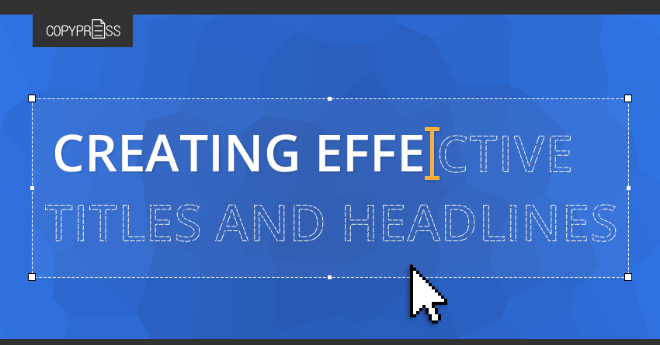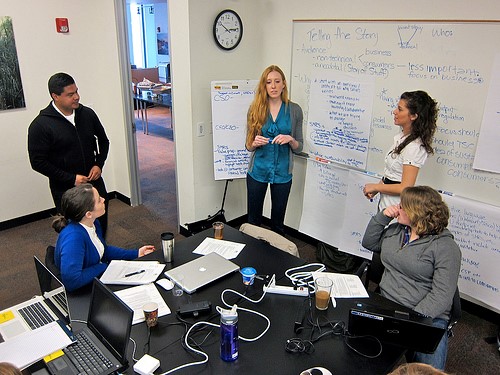Titles and headlines introduce your articles and blog posts to the world.
An effective title ensures the people you want to attract click on your piece and start reading. A bad title or headline, though, is all anyone will ever see of your piece.
The process to create catchy titles and headlines takes time, but by following the right guidelines, you can become a headline-writing master.

Journalism Rules (Sometimes) Apply
When studying journalism, writers learn the five W's (and H) for gathering information. The five W's are:
- Who
- What
- When
- Where
- Why
- and How.
Those same five W's and H are useful in creating headlines. To write an effective headline, ask who, what, when, where, why, and how of your content. Answer these six questions, then decide the key element that will tell readers what the piece is really about.
Your article or infographic might answer the question "Where should I go on vacation?" That doesn't mean your headline, however, should be "Where to Go on Vacation."
Such a headline is not specific enough; it's not catchy, and you can do better. Delve deeper into the process to start writing clickable and shareable headlines.
Distinctive Hooks Are Key
Neil Patel has added his "four U's" to help you write headlines that attract an audience.
Patel advises you to make your headline:
- Unique
- Ultra-specific
- Urgent
- Useful.
Hooks aren't always clever. Sometimes, hooks are completely obvious in their attempts to grab your attention.
Think of all the clickbait you've seen with phrases such as:
- "You Won't Believe What Happened Next"
- "You Would Never Guess"
- "The Reason Why Will Shock You"
- "This Simple Trick"
- "Everyone is Talked About"
Urgent? Sure. Useful? Not really. And worse, they're often misleading—the content rarely delivers on the promise of the title.
To create a successful hook, you want to find a happy medium.
Think about the elements of those titles that sucked you in because you had to find out what happened next. Then think about what your article really delivers. You want to follow the same principle—grab attention with your headline—albeit more creatively.
Brainstorm, Brainstorm, Brainstorm

Image via Flickr by Kevin Dooley
Still stuck? Try using SVO:
- Subject
- Verb
- Object.
Explain your article in the subject, verb, object formula and you'll create a solid description of your post; SVO will help you come up with a descriptive title that accurately portrays the content within.
Once you have that basic idea, start brainstorming.
Use current events, pop culture, old content, and hyperbole to add and change the basic headline. Add adjectives and adverbs, or change the verbs to more interesting terms. Try alliteration.
The English language is full of tricks to catch the eye and attract readers. The more ideas you generate, the better you'll become—and the more likely you are to strike gold.
Think About Your Audience

Image via Flickr by TopRank Marketing
While you're brainstorming, keep your audience in mind.
"Spring Break Destinations Worthy of Your Best Bikini" isn't going to fly on a blog that caters to DIY fans in their 40s and 50s.
Internet headlines aren't like newspaper headlines. The headings can include slang, bad grammar, and total weirdness. But you have to write for the right audience on the right site to get away with your approach.
Learning when to use the latest slang and grammar trends and when to stay in the Oxford English Dictionary's good graces is an important part of creating headlines.
Where do you start?
If you're writing for a client, make sure you know what the client wants. Regardless of the audience, if the client doesn't want slang, don't deliver slang.
Then, figure out the goals of the piece. Are you catering to the audience you already have or attracting a new group of readers? How does this piece fit within your SEO keyword research?
While brainstorming, play around with edgy headlines and go further with your creativity than you think is proper. You're allowed to go beyond the boundaries of the assignment to stretch your brain and come up with the best headline.
A bit of rule-bending might lead to your "aha" moment.
Research Similar Content
Once you've brainstormed some fabulous title and headline concepts, go to your favorite search engine to find what other people have written on the same topic.
You don't want to regurgitate what five other articles have already covered unless you have a distinctive spin. Looking up content already published helps you in several ways:
- First, you'll get ideas from the headlines you find.
- Second, you can find gaps in the information that you can fill with your own articles.
- Third, you'll get ideas for new angles or updates for old content.
Don't underestimate the power of search.
Review Your Headline Before Publishing
After you've written the content, check your title one more time.
Does it still fit the article, or has the heart of the piece changed since you came up with the headline? Don't be afraid to change your headline to suit the content you created.
Never be afraid to push your own boundaries. Finding a new way to look at a concept, spin a story, or deliver information is at the heart of what makes your creative content clickable.
The Full Infographic


